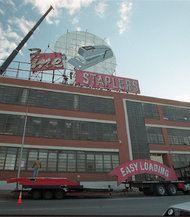If you do, maybe it’s a little dusty in this age of PDFs. Or maybe it’s been missing for a while, after someone borrowed it and never brought it back. Or maybe you’ve affixed your name to your stapler with a piece of clear tape, so your co-workers know: you take this stapler, you die.
Even as data moves to computers and the cloud, staplers continue to help people keep it together. On the computer, we can file copies in folders and send messages to mailboxes. We can cut, copy and paste text and files. But which computer activity is similar to stapling? Sure, there’s the paper-clip icon that attaches documents to e-mail. But nothing, really, comes close to the satisfying ka-chunk of a stapler: it’s a sound that means work is getting done.
Paper receipts are supposed to be on their way out, but they continue to flutter their way through restaurants, stores and doctors’ offices. Staplers are there, attaching the receipt to the business card, the return receipt to the original receipt, the merchant copy to the bill, the receipt to the takeout bag.
If you have a stapler, the odds are fairly good that it was made by Swingline. Other companies, including Stanley-Bostitch, along with OfficeMax and Staples, also make staplers. But Swingline, now owned by Acco Brands, has long been the market leader.
Acco, based in suburban Chicago, sounds like the perfect name for a faceless conglomerate from the era of “The Man in the Gray Flannel Suit.” But it actually has a sterling office products pedigree — it is short for the American Clip Company, a manufacturer of paper clips founded by Fred. J. Kline of Queens at the turn of the 20th century.

Ruby Washington/The New York Times
Signs at Swingline’s old plant in Queens came down in 1999.
Queens was once the center of the paper-fastening universe. In 1925, it was where Jack Linsky founded the Parrot Speed Fastener Company, later renamed Swingline. For years, the bright red sign of his Swingline factory was a beacon to Queens residents as they drove across the Queensboro Bridge from Manhattan.
Stapling devices have existed since at the least the French court of Louis XV. But before Mr. Linsky’s time, staples generally had to be laboriously loaded, one by one, into the rear of the stapler. Mr. Linsky helped revolutionize stapling by creating an easy way to fill the devices under a horizontal cap. He found an adhesive that could attach staples in rows so that they stayed together in a metal magazine until they were pushed out and bent individually to grip their paper quarry.
Swingline promised to make office work easy. In a newspaper ad from the 1940s, a young woman — presumably a secretary — loads a stapler and says: “Now we’re in the groove, boss! That Swingline Stapler loads quicker, works slicker because of its open, trouble-free channel.”
But Mr. Linsky wasn’t satisfied to serve only the office market; he helped increase demand for staplers by emphasizing their handiness in other tasks, like tacking shelf paper, fastening paper around sandwiches and constructing party hats. (“Swingline does the darnedest things!” another ad boasted.) He also expanded the business by making specialized staplers for carpeting, roofing and auto upholstery.
In 1970, Mr. Linsky sold Swingline to American Brands, and in the next decade Acco merged into Swingline. Amid the manufacturing crisis of the 1990s, American Brands closed the Swingline factory in Queens and moved its manufacturing to Mexico; nearly 500 New York workers lost their jobs, and the Swingline sign came down. Now most staplers are produced in Asia.
Swingline made Mr. Linsky very rich. He and his wife, Belle, were philanthropists and art collectors who once owned one of the largest collections of Fabergé eggs in America. Jack died in 1980, and in 1982 Belle donated a collection of the couple’s European art, then worth $60 million, to the Metropolitan Museum of Art.
Staplers generally don’t rise to the level of prized collectibles, which is why a Swingline’s role as an object of obsession was so funny in the 1999 cult comedy”Office Space.”
Article source: http://www.nytimes.com/2013/03/24/business/staplers-the-attachment-thats-still-making-noise.html?partner=rss&emc=rss
Speak Your Mind
You must be logged in to post a comment.